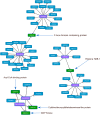Deep sequencing of wheat sRNA transcriptome reveals distinct temporal expression pattern of miRNAs in response to heat, light and UV
- PMID: 28004741
- PMCID: PMC5177929
- DOI: 10.1038/srep39373
Deep sequencing of wheat sRNA transcriptome reveals distinct temporal expression pattern of miRNAs in response to heat, light and UV
Abstract
Understanding of plant adaptation to abiotic stresses has implications in plant breeding, especially in the context of climate change. MicroRNAs (miRNAs) and short interfering RNAs play a crucial role in gene regulation. Here, wheat plants were exposed to one of the following stresses: continuous light, heat or ultraviolet radiations over five consecutive days and leaf tissues from three biological replicates were harvested at 0, 1, 2, 3, 7 and 10 days after treatment (DAT). A total of 72 small RNA libraries were sequenced on the Illumina platform generating ~524 million reads corresponding to ~129 million distinct tags from which 232 conserved miRNAs were identified. The expression levels of 1, 2 and 79 miRNAs were affected by ultraviolet radiation, continuous light and heat, respectively. Approximately 55% of the differentially expressed miRNAs were downregulated at 0 and 1 DAT including miR398, miR528 and miR156 that control mRNAs involved in activation of signal transduction pathways and flowering. Other putative targets included histone variants and methyltransferases. These results suggest a temporal miRNA-guided post-transcriptional regulation that enables wheat to respond to abiotic stresses, particularly heat. Designing novel wheat breeding strategies such as regulatory gene-based marker assisted selection depends on accurate identification of stress induced miRNAs.
Figures





Similar articles
-
Uncovering leaf rust responsive miRNAs in wheat (Triticum aestivum L.) using high-throughput sequencing and prediction of their targets through degradome analysis.Planta. 2017 Jan;245(1):161-182. doi: 10.1007/s00425-016-2600-9. Epub 2016 Oct 3. Planta. 2017. PMID: 27699487
-
Identification and expression profiling of Vigna mungo microRNAs from leaf small RNA transcriptome by deep sequencing.J Integr Plant Biol. 2014 Jan;56(1):15-23. doi: 10.1111/jipb.12115. Epub 2013 Dec 19. J Integr Plant Biol. 2014. PMID: 24138283
-
Identification and Characterization of MicroRNAs in Ginkgo biloba var. epiphylla Mak.PLoS One. 2015 May 15;10(5):e0127184. doi: 10.1371/journal.pone.0127184. eCollection 2015. PLoS One. 2015. PMID: 25978425 Free PMC article.
-
MiR398 and plant stress responses.Physiol Plant. 2011 Sep;143(1):1-9. doi: 10.1111/j.1399-3054.2011.01477.x. Epub 2011 May 19. Physiol Plant. 2011. PMID: 21496029 Review.
-
Regulatory role of microRNAs (miRNAs) in the recent development of abiotic stress tolerance of plants.Gene. 2022 May 5;821:146283. doi: 10.1016/j.gene.2022.146283. Epub 2022 Feb 7. Gene. 2022. PMID: 35143944 Review.
Cited by
-
Comprehensive, integrative genomic analysis of microRNA expression profiles in different tissues of two wheat cultivars with different traits.Funct Integr Genomics. 2022 Dec 23;23(1):15. doi: 10.1007/s10142-022-00920-1. Funct Integr Genomics. 2022. PMID: 36562829
-
Heat-responsive microRNAs participate in regulating the pollen fertility stability of CMS-D2 restorer line under high-temperature stress.Biol Res. 2023 Nov 9;56(1):58. doi: 10.1186/s40659-023-00465-y. Biol Res. 2023. PMID: 37941013 Free PMC article.
-
Site-specific analysis reveals candidate cross-kingdom small RNAs, tRNA and rRNA fragments, and signs of fungal RNA phasing in the barley-powdery mildew interaction.Mol Plant Pathol. 2023 Jun;24(6):570-587. doi: 10.1111/mpp.13324. Epub 2023 Mar 14. Mol Plant Pathol. 2023. PMID: 36917011 Free PMC article.
-
Wheat Long Noncoding RNAs from Organelle and Nuclear Genomes Carry Conserved microRNA Precursors Which May Together Comprise Intricate Networks in Insect Responses.Int J Mol Sci. 2023 Jan 23;24(3):2226. doi: 10.3390/ijms24032226. Int J Mol Sci. 2023. PMID: 36768565 Free PMC article.
-
Arbuscular mycorrhizal fungi improve the growth and drought tolerance of Cinnamomum migao by enhancing physio-biochemical responses.Ecol Evol. 2022 Jul 11;12(7):e9091. doi: 10.1002/ece3.9091. eCollection 2022 Jul. Ecol Evol. 2022. PMID: 35845374 Free PMC article.
References
-
- Torres M. A. & Dangl J. L. Functions of the respiratory burst oxidase in biotic interactions, abiotic stress and development. Curr Opin Plant Biol 8, 397–403 (2005). - PubMed
-
- D’Autreaux B. & Toledano M. B. ROS as signalling molecules: mechanisms that generate specificity in ROS homeostasis. Nat Rev Mol Cell Biol 8, 813–824 (2007). - PubMed
-
- Asai T. et al.. MAP kinase signalling cascade in Arabidopsis innate immunity. Nature 415, 977–983 (2002). - PubMed
Publication types
MeSH terms
Substances
LinkOut - more resources
Full Text Sources
Other Literature Sources
Molecular Biology Databases

